Actress, Playwright, Author, and Face of Fashion
All hats featured in this article are from the estate of Anita Loos, as previously owned and sold by Lester Glassner.
She was born Corrine Anita Loos in 1889 in California to financially comfortable, but unhappy parents. Her father, "Beer" Loos, was a tabloid editor, reveler, and alcoholic. Her mother, Minerva, was a proud and resilient woman who ran a series of papers for Beer, who was often too drunk to do so.
Anita was raised in a household of interesting standards. Since her parents were opposites, she had the unique experience of spending separate time with both. She began with learning professionalism from her mother, and the paradox from her father.
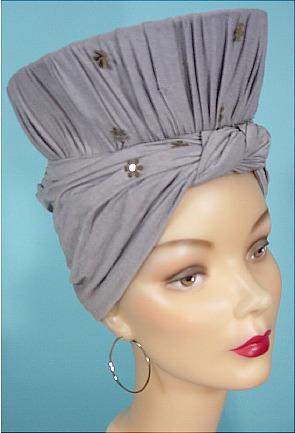 |
| c. 1940s Jersey Turban Hat |
Regardless of Beer's habits, Anita followed him everywhere. In order to get colorful stories to keep the paper afloat, Beer would explore the San Francisco underbelly. He often took his daughter along on his missions to brothels, bordellos, and drug dens--which she, ironically, came to enjoy. These trips would usually end with Beer partaking in what these locations had to offer, and not so much retrieving a story.
It was around this time that Anita began acting in stock productions of vaudeville performances. She was further urged in her fledgling acting career when her father became the manager of a theater company in San Diego. Although Anita was what many considered a very good actress, she found her true passion to be writing.
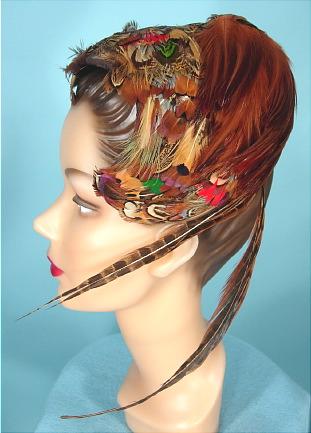 |
| c. 1950s Pheasant Feather Hat |
In 1911, Anita wrote three plays in quick succession. She sent her piece The New York Hat to the Biograph Company, not expecting much to come of it. Much to her surprise, The New York Hat was picked up--and by none other than the era's most prolific director D.W. Griffith.
The film starred silver screen heavyweights Lionel Barrymore and Mary Pickford.
Loos was a sensation overnight. Practically obsessed with her new-found niche, she pulled most of the topics of her writing from actual instances. Her father's habits, cronies, and the lifestyles she witnessed as a child from the lowlifes she encountered on excursions with Beer painted the backdrops for some of her best work. Between 1912 and 1915, Anita would turn out 105 scripts to two different studios.
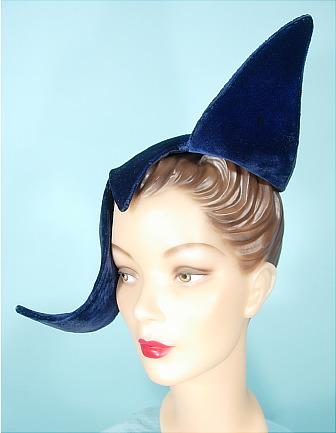 |
| c. 1950s Robert Dudley Hat |
Of those 105, only 4 went unproduced.
Despite her growing fame, Loos was still experiencing pressure from the unpleasant side of her past--that which had once given her so much inspiration. Her father, often broke, was always begging her for more money. Her mother, practically overbearing, was trying to keep her from following her work to Hollywood.
In order to escape their influence, Anita made the unwise decision to marry Frank Pallma Jr. in 1915. He was the son of a band conductor, and despite being upstanding and nice, Loos grew bored of him after only six months.
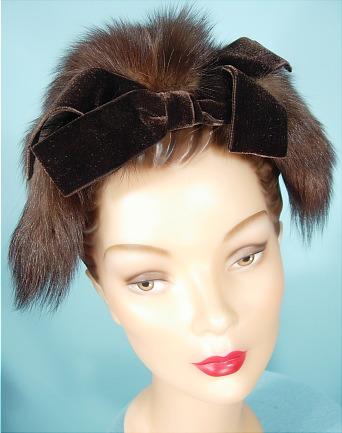 |
| c. 1960 Sable Fur Hat |
The break with Pallma gave Loos the freedom she had been looking for. She was swiftly snatched up by Triangle Film Corporation, for $75 a week, and a bonus for every script she produced. D. W. Griffith became one of her biggest supporters, although he was picky to turn most of her pieces into films because "the laughs are all in the lines, there's no way to get them onto screen".
He did, however, often ask her to write the subtitling for his films (as talkies were not yet invented). She traveled to New York for the first time to attend the premier of his film Intolerance, and falling in love with the atmosphere, she decided to stay.
In New York, she hobnobbed with Frank Crowninshield, who was so impressed with her that he asked her to become a regular contributor to his journal, Vanity Fair. She would remain so for several decades.
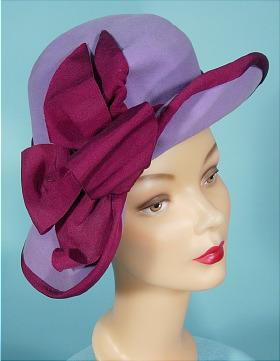 |
| c. 1940s Lavender Felt Hat |
When Loos returned to California, she came under the interest of John Emerson, who asked her to assist him in writing a few pieces for the very popular actor, Douglas Fairbanks. The five films that followed made Fairbanks' star utterly explode. When Fairbanks was offered bigger money at another studio, he brought the Loos-Emerson team along with him, to the tune of $500 a week.
Anita Loos' name was now as well-known as those of Mary Pickford and Lillian Gish.
During this time, Emerson and Loos were working close together all the time. Anita was convinced that she was in love, and though Emerson was known notoriously for uttering "never been, nor could be, faithful to any one female", she pursued him. Emerson would catch on to her affections, and use them to take credit for most of Loos' work during this period.
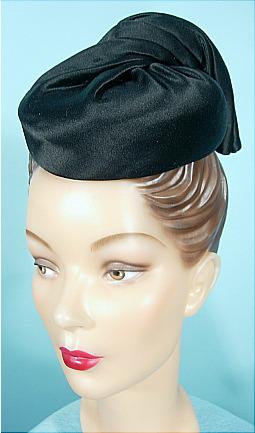 |
| c. 1940s Balenciaga |
Yet, in order to prove her identity was not to be changed by her new marital status, Loos kept her maiden name.
Emerson insisted on riding Anita's coattails through much of her success. Studios would hire her out to write for their movies, and as a courtesy she would often bring along Emerson--though his presence was often as unneeded as it was unwanted. Emerson was considered so much of a burden, that the Talmadge-Schecnks (a powerful Hollywood family) convinced Anita to holiday with them in Paris without her husband.
When Anita returned, Emerson devastated her by insisting he needed a "break from marriage" once a week. He chose to date younger women on those days, and Loos resorted to holding parties in her house with her friends to find comfort.
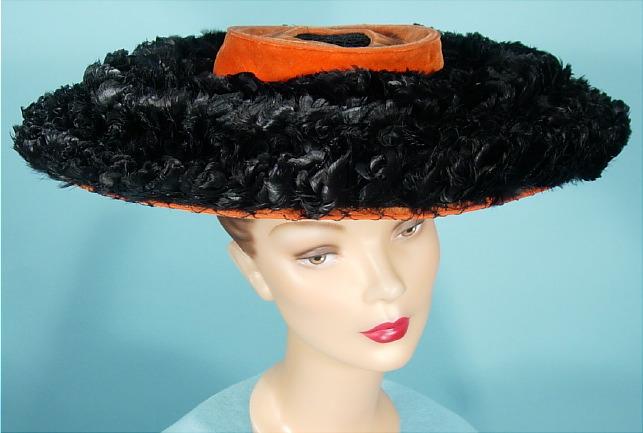 |
| c. 1950s Velvet Pumpkin Hat |
However, things were changing. Loos, throwing herself into her work, managed to complete a series of sketches that were in turn published in Harper's Bazaar. These pieces were collectively known by the title Gentlemen Prefer Blondes. The stories revolved around the antics of Lorelei Lee, a bold, ambitious flapper, who shamelessly used men for their monetary means.
The print was such a success, Loos found herself being pushed to write an entire book.
It was 1925, and Blondes was modestly published in November of that year. It sold out overnight, and Anita received thousands of fan letters, and even a few from fellow authors--Aldous Huxley, William Faulkner, and Edith Wharton among them.
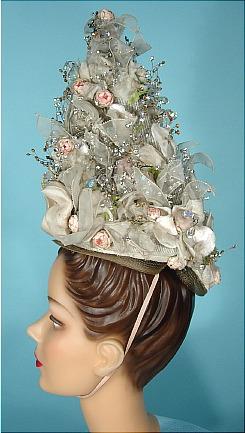 |
| c.1940s Mad Crystal Hat |
Emerson, perhaps foreseeing the success of his wife's new novel, did whatever he could to block it's publication. Taking it a step further, he developed a severe hypochondria, in an attempt to keep some of Loos' attentions to himself. Emerson often told her that the only way he could "get better" is if she gave up her career.
Loos, whose heart was now hardened, refused.
The crash of the stock market resulted in a limited income for both individuals, at which time Loos wrote But Gentlemen Marry Brunettes. Loos and Emerson moved into a modest hotel apartment in 1931, and in the transit of this move, Loos discovered letters between Emerson and one of his lovers. In these letters, Emerson had described his marriage as "unfulfilled".
Loos offered Emerson a divorce, he rebuffed. Anita moved out on her own accord, and took up a small apartment. Irving Thalberg (genius young director and husband of rising star Norma Shearer) called upon the Loos-Emerson team to write pictures at MGM. Emerson refused. Loos agreed, and took the $1,000 a week salary for herself.
 |
| c. 1950s Bergdorf Goodman Hat |
It was only after having him committed that Loos discovered that most of her money had been moved from she and Emerson's joint account, into his private account.
Though Loos would push for divorce for years to come, she and Emerson remained legally married until his death in 1956.
With the onslaught of WWII, Loos continued to write, and focused her energies on gardening and the war effort. She continued to make her appearance at various venues, always appearing fashionable yet modest. She continued to write fervently for Harper's Bazaar, The New Yorker, and Vanity Fair.
In her later years, Loos enjoyed her freedom. She was regularly spotted at dinners out with friends, at parties, galas, and award ceremonies well into her 80s.
Loos passed away after suffering a lung infection in 1981, at the age of 92.
All photos are from ANTIQUEDRESS.com All of Ms. Loos' hats from this collection are being sold through my website. I would have loved to keep them all together, but sadly it was not possible. Here's the link to all the other hats... with more coming!
ReplyDeletehttp://antiquedress.com/galleryspecialanitaloos.htm
Yes, there are links under the hats that directly connect to your website. I should have actually further cited your website, sorry about that. I will remember to do so in the future. (:
DeleteThere is a non profit foundation sited in the former residence of anita Loos' brother, Dr. Clifford Loos. Anita was his hostess between the two World Wars and her Santa Monica Canyon Salons became famous as a wildly eclectic mix....an intellectual and creative mecca. Einsten, Hubble, Huxley, Hearst, Gershwin, Berlin, Chaplin, the Talmadage girls, Mary Pickford, Doug Fairbanks, etc. were frequent guests. But equally important to keep them interesting were those guests who dropped in when they were in town. Man Ray, Edward Steichen (who also did a pastels sketch of Anita)Lee Miller, Stokowski who talked Anita introducing him to Greta Garbo. Anita gave La Senora some of her hats and some of her jewelry because they were too small to fit anyone else she knew. These treasures I passed along to La Senora. If you wind up with anything you think should be gifted, it is an established 501[c]3 and gives donation receipts for items in its collections. www.lasenora.org Enjoyed your article and especially the beautiful hats.
ReplyDeleteJust went to your site and saw the video too. Your 'obsession' is a delight. I too collect antique lingerie and hang it out on my walls to enjoy as 'an art form'. I collected lace curtains for my windows until I discovered the 'sun damage' problem. These materials want to be kept in shaded areas.
ReplyDeleteGreat post I would like to thank you for the efforts you have made in writing this interesting and knowledgeable article.
ReplyDeletePhoenix